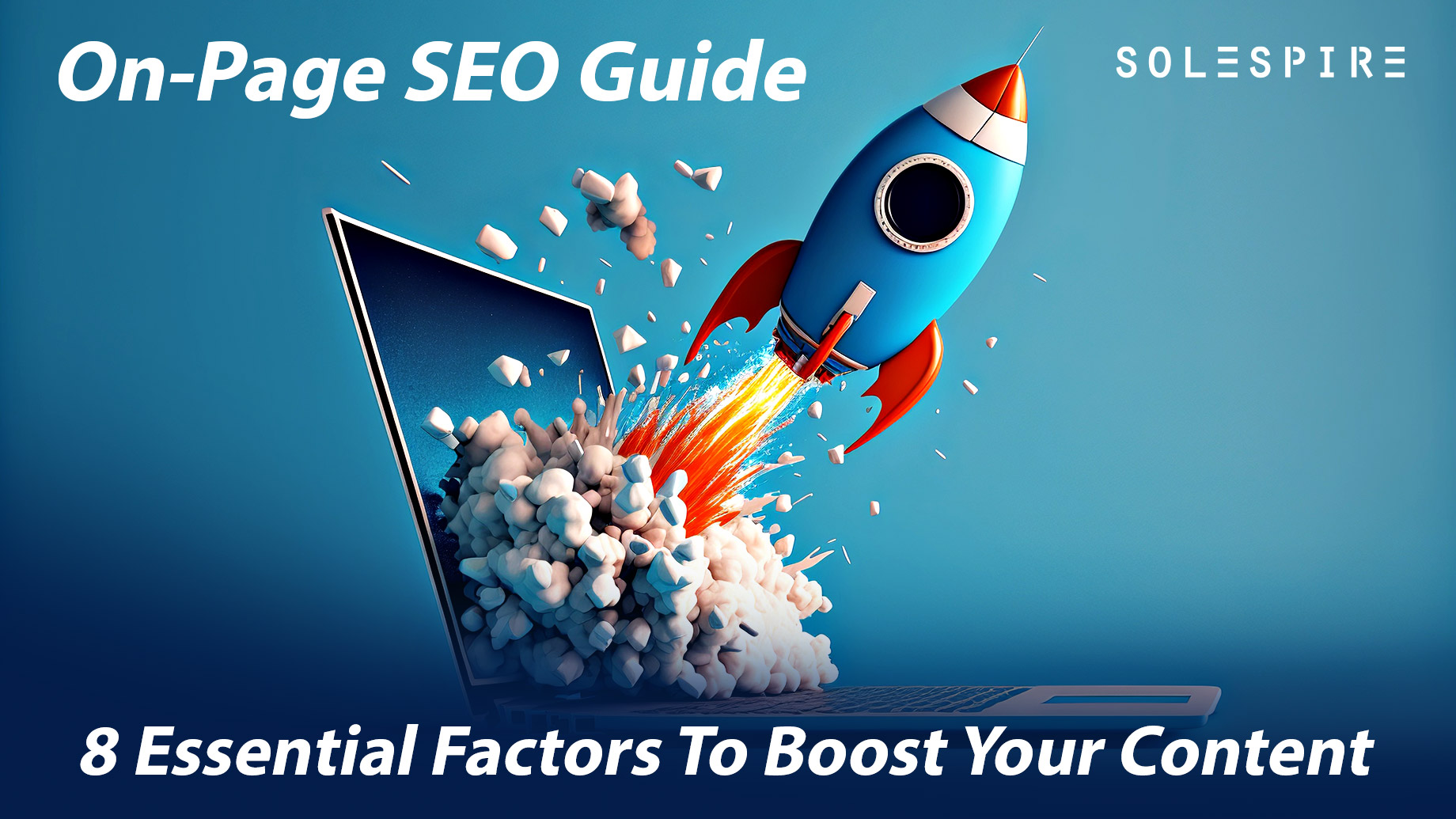
Search Engine Optimization (SEO) is a critical aspect of online marketing. It is the process of optimizing a website or individual webpages to rank higher in search engine results pages (SERPs). On-page SEO is the specific practice of optimizing individual webpages to rank higher in search engine results and earn more relevant traffic.
In this article, we will be discussing eight important on-page SEO elements, factors, and tips to help you improve your website’s visibility in search engine results. These include title tags, headings, rich content, internal links with anchor text, on-page E-A-T signals, alt text descriptors for images, content that answers questions, and valid schema markup.
By understanding and implementing all of this, together with the knowledge of how Google Search works, and likewise how Bing works, businesses can improve their website’s visibility in search results and drive more relevant traffic to their site, by utilizing the following on-page SEO factors and strategies to boost their content:
1. Title Tags
Title tags, also known as title elements, are HTML tags that describe the title of a webpage. As one of the most important on-page SEO factors, title tags are displayed in the browser’s tab and as the clickable headline for a webpage in search engine results. Title tags should be unique for each page and accurately describe the content of the page. They should also be kept under 60 characters to ensure that they are not truncated in search results.
The following are examples of effective title tags:
- “Best Yoga Studios In Los Angeles – Find Your Zen”
- “Organic Produce Delivery: Fresh and Local”
- “Secrets To Success In Luxury Real Estate Marketing”
- “Car Maintenance 101: How To Keep Your Car Running Smoothly”
You should also try to include your main keywords in your title tags, but also make sure they look natural and don’t seem like you are trying too hard to fit keywords in, as this can negatively impact your on-page SEO.
Here are more examples of title tags:
- “Get The Best Travel Deals: Compare Multiple Airline Prices”
- “The Best Healthy Food Delivery Services In The U.S.”
- “Everything You Need To Know About Buying A Used Car”
- “Top 10 Most Visited Tourist Attractions In Europe”
- “A Beginner’s Guide To Investing In The Stock Market”
Additionally, it is important to note that title tags should be written with the user in mind, not only for SEO, as they are the first thing that will be seen by the user when they click on a link in search engine results.
2. Headings
Headings, also known as H1, H2, and H3 tags, are used to organize and structure the content of a webpage. They help search engines understand the hierarchy of a page and its content. The H1 tag is typically reserved for the title of the page, while H2 and H3 tags are used for subheadings. It’s important to use headings correctly and not stuff them with keywords.
Here is an example of how to use article headings and subheadings correctly in a blog:
- H1: “The Science Of Sleep: Understanding And Improving Your Sleep Cycle”
- H2: “The Importance Of REM Sleep”
- H3: “What is REM Sleep and Why is it Important?”
- H3: “Tips for Improving REM Sleep”
- H2: “The Role Of Melatonin In Sleep”
- H3: “What is Melatonin and How Does it Affect Sleep?”
- H3: “Ways to Boost Melatonin Production Naturally”
- H2: “The Importance Of REM Sleep”
Another informative example:
- H1: “The Art Of Photography: Techniques And Tips For Beginners”
- H2: “Equipment And Camera Settings”
- H3: “Choosing the Right Camera for Your Needs”
- H3: “Understanding ISO, Aperture, and Shutter Speed”
- H2: “Composition And Lighting”
- H3: “The Rule of Thirds and Other Composition Techniques”
- H3: “Shooting in Natural Light vs. Artificial Light”
- H2: “Equipment And Camera Settings”
Here’s one more example, for good measure:
- H1: “The History Of Jazz Music”
- H2: “Early Jazz and its Origins”
- H3: “The Role of African American Culture in the Development of Jazz”
- H3: “Influential Jazz Musicians of the Early 20th Century”
- H2: “Jazz in the 1940s and 1950s”
- H3: “The Evolution of Bebop and Cool Jazz”
- H3: “Jazz in the Civil Rights Movement”
- H2: “Early Jazz and its Origins”
It’s also important to remember that headings should be used in a logical and structured way, and also should be used sparingly, as too many headings can make the content hard to follow and can devalue the on-page SEO. Additionally, it is important to use relevant keywords in your headings, but also to make sure they are not overused and appear to sound natural.
3. Rich Content
Rich content refers to content that goes beyond basic text and includes elements such as images, videos, infographics, and interactive elements. These types of elements can help increase engagement and make a webpage more visually appealing, which can also signal to search engines that the page is high-quality and valuable. Thus, it’s important to use relevant, high-quality multimedia, and to optimize them with descriptive file names and alt text.
Here are three examples of how to incorporate rich content on a webpage:
- For a travel blog, include a map of the destination with markers for popular landmarks, a video tour of the city, and an interactive quiz that tests users’ knowledge of the destination.
- For a product review page, include a video demonstration of the product in action, a comparison chart that shows the features of different models, and user-generated reviews with images and ratings.
- For a news article, include videos of interviews with experts, infographics that explain complex data, and interactive polls that allow users to share their opinions.
Here are several more examples that illustrate how you can use rich content on niche websites:
- For a fashion e-commerce site, include videos of clothes in action, how-to guides, and a virtual try-on feature that allows users to see how the clothes will look on them.
- For a car review website, include videos of test drives, virtual tours of the cars, and an interactive comparison tool that allows users to compare different models side-by-side.
- For a fitness website, showcase videos of exercises, animations that show how to properly perform the exercises, and a workout planner that creates a customized workout plan for the user.
- For a recipe website, include high-quality images of the finished dish, step-by-step instructions with images, and a video of the recipe being prepared.
- For a real estate website, include virtual tours, floor plans, and an interactive map that shows nearby amenities such as schools, parks, and transportation.
By including rich content on a webpage, you can make it more engaging and informative for users and also help improve the on-page SEO by providing more context and value to the user and search engines. It’s important to note that rich content should be relevant and add value to the content, and also should be optimized for both speed and accessibility to ensure that users have a positive experience.
4. Internal Links with Anchor Text
Internal links are hyperlinks from one page on a website to another page on the same website. They are important for on-page SEO because they help search engines understand the structure and hierarchy of a website, and they also help users navigate the site. Anchor text is the clickable text that is used in a link, and it’s important to use descriptive and relevant anchor text for internal links.
The following three examples demonstrate best use-cases of inserting internal links:
- In an article about “The Best Hikes In Yosemite National Park,” include a link to a separate page with detailed information about each hike.
- In a blog post about “The Importance Of Regular Maintenance For Your Car,” include a link to a page with a list of recommended service centers.
- In an online store, include links to related products within product descriptions.
Note that internal links should be used in a logical and structured way, and also should be used sparingly to avoid overwhelming the user. Additionally, it is important to use relevant keywords in your anchor that sound natural within the flow of your content structure.
5. On-Page E-A-T Signals
On-page E-A-T (Expertise, Authoritativeness, Trustworthiness) signals refer to elements on a webpage that indicate to search engines that the content is high-quality, trustworthy, and written by an expert or authority in the field. On-page E-A-T signals include things like author bios, contact information, and testimonials. They can help establish a website’s credibility and increase its chances of ranking well in search results.
These are examples of how to incorporate on-page E-A-T signals onto an individual webpage:
- For a health and wellness website, include author bios that highlight the qualifications and experience of the writers, and also include references and citations for any medical or scientific information that is included in the articles.
- For a financial advice website, include author bios that highlight the qualifications and experience of the writers, as well as any professional certifications or licenses they hold, such as a CFP (Certified Financial Planner) or CFA (Chartered Financial Analyst).
- For a news website, include author bios that highlight the qualifications and experience of the writers, and also include information about the news organization and its history, mission, and values.
- For a product review website, include information about the testing methods and criteria that were used to evaluate the products, as well as information about the reviewers, such as their qualifications and experience.
The following are examples of how to incorporate E-A-T signals on a website at scale:
- Include an “About Us” page with information about the website and its authors and their qualifications.
- Include a “Contact Us” page with a physical address, if applicable, as well as phone numbers, email addresses, and links to social media profiles.
- Include customer testimonials on product or service pages.
It’s important to remember that E-A-T signals should be relevant and accurate, and also should be used in a way that is not misleading or fake, as this will harm the credibility of the website. Additionally, it’s important to note that E-A-T signals are just one part of the overall ranking algorithm and not the sole factor that search engines use to rank a website.
6. Descriptive Image Alt Text
Alt text is a small piece of text that is added to an image to describe its content. This text is used by search engines and assistive technologies, such as screen readers, to understand the content of an image. It’s also used in case the image fails to load. Descriptive alt text should accurately describe the image and include relevant keywords when appropriate.
These are general examples of good alt text for images:
- “Golden Retriever puppy playing with a tennis ball”
- “Close-up of a sliced avocado with a spoon”
- “The Eiffel Tower at sunset with the Seine river in the background”
Here are extensive examples of how to use descriptive image alt text on niche websites:
- For an e-commerce website, use descriptive image alt text to describe the product that is shown in the image. For example, “Red Nike Air Max sneakers, size 11”
- For a news website, use descriptive image alt text to describe the content of the image. For example, “President Joe Biden delivering a speech at the White House”
- For a beauty website, use descriptive image alt text to describe the makeup or skincare product that is shown in the image. For example, “NARS Radiant Longwear Foundation in shade Barcelona”
- For a fitness website, use descriptive image alt text to describe the exercise that is shown in the image. For example, “A person performing a deadlift with a barbell”
- For a real estate website, use descriptive image alt text to describe the property that is shown in the image. For example, “A 12-bedroom, 21-bathroom house in Los Angeles”
Noteworthy is the fact that alt text is not visible on the webpage, and it is used for accessibility and SEO purposes only.
7. Content That Answers Questions
One of the goals of SEO is to provide users with relevant and useful information. Creating content that answers specific questions can help increase a webpage’s visibility in search results and provide the ultimate goal of value for users, which increases the likelihood that they will visit your website again for more valuable content. To achieve this, you can include things like FAQ pages, how-to guides, and tutorials.
The following are examples of content types that answers questions:
- A blog post of a “How To Start A Garden” guide that includes step-by-step instructions and tips.
- A listicle article of “What To Pack For A Beach Vacation” with suggestions and recommendations.
- An FAQ page for a software product that addresses common issues and concerns.
These are examples of how to create content that answers questions on niche topical websites:
- For a financial website, create an FAQ page that answers common questions about retirement planning. This page could include information on the different types of retirement accounts, how to calculate how much money you’ll need to retire, and strategies for saving and investing.
- For a travel website, create a how-to guide that answers the question “How to plan a budget-friendly road trip?” This guide could include information on budget-friendly accommodation options, how to plan an itinerary, and tips for saving money on food and activities.
- For an automotive website, create an FAQ page that answers common questions about electric cars, such as how far electric cars can travel on one charge, the cost to charge an electric car, and the environmental benefits of driving an electric car.
By providing content that answers questions, you can help your audience find the information they need, while also showing search engines that your website is a valuable resource for information on a particular topic. Additionally, by providing answers to questions that are frequently asked, you can improve the user experience and also reduce the bounce rate of your website.
8. Valid Schema Markup
Schema markup is a type of code that can be added to a webpage to provide search engines with additional information about the page’s content. This can include things like business hours, reviews, and pricing. Using valid schema markup can help increase a webpage’s visibility in search results and make it more likely to be featured in rich snippets.
The following are three examples of how to contextually use schema markup on your website:
- For business hours of operation and location on a “Contact Us” page.
- To provide information about a product’s reviews and ratings on a product page.
- For information about an event’s date, location, and schedule on an event page.
Three more examples of valid schema markup you can use on various types of websites:
- For an e-commerce website, use schema markup to provide information about the product’s name, price, reviews, and availability. This can help search engines understand that your website is a valuable resource for online shopping and can help your website to appear in search results for product-related queries.
- For a local business website, use schema markup to provide information about the business’s name, address, phone number, and opening hours. This can help your website appear in search results for local-related queries.
- For a news website, use schema markup to provide information about the author, publication date, and article’s headline. This can help your website to appear in search results for news-related queries.
By using valid schema markup, you can help search engines to better understand the content on your website and improve your website’s search engine rankings. Additionally, it can also provide a better user experience by getting your content featured in rich snippets on the search engine results page.
Conclusion
On-page SEO is essential for any business looking to improve its visibility in search engine results and drive more relevant traffic to its site. By understanding and implementing these important on-page SEO elements, such as title tags, headings, rich content, internal links with anchor text, on-page E-A-T signals, descriptive image alt text, content that answers questions, and valid schema markup, businesses will increase their chances of boosting their content to the top of SERPs on Google, Bing, Yahoo, DuckDuckGo, Yandex, Qwant, and many more rising search engines.

